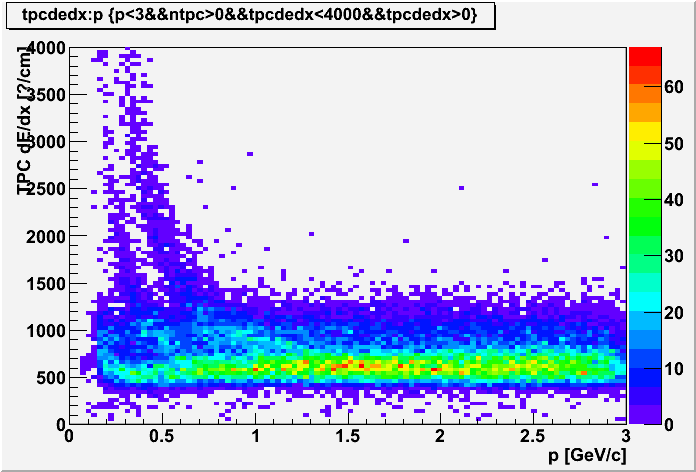| TPC dE/dx [message #11557] |
Tue, 08 March 2011 15:54  |
 StefanoSpataro
StefanoSpataro
Messages: 2736
Registered: June 2005
Location: Torino
|
first-grade participant |

From: *to.infn.it
|
|
Dear all,
I have tried to write a "quick and dirty" algorithm to calculate TPC dE/dx with a truncated mean -> pid/PidCorr/PndPidTpcInfo.cxx
The energy is taken from PndTpcCluster::amp(), the dx is calculated somehow from the distance of consecutive hits, as a first approximation (in reality it is the sum of the semi-distance with the previous hit and the semi-distance with the next hit).
This is the plot I obtain, after 10k events * (p + e + pi + mu + k) with the box generator:

If I compare the plot to what present in the TPR, page 142 of the pdf, I have some questions:
a) What is the unity of PndTpcCluster::amp()? If I assume it is in GeV as the pandaroot standard, I obtain a around MeV/cm, while I suppose it should be something like keV/cm. And the numbers are still different. (I am using Geant3+Alice settings) Maybe the gas mixture was changed?
b) the plot is worse than the TPR one, because it is using reconstruction and not MC, but it looks like electrons are less separated now than the old plot (where they were quite far). Here they are overlapping with a bit higher de/dx, you are not able to find them like in the TPC plot. This is not clear to me.
Comments from experts are welcome.
|
|
|
|
| Re: TPC dE/dx [message #11558 is a reply to message #11557] |
Tue, 08 March 2011 16:02   |
|
Anonymous Poster
|
|
From: *e18.physik.tu-muenchen.de
|
|
Hi Stefano,
could you please use another momentum region for you generation? For example [0.1,1.] GeV/c? The interesting region in this plot is not very visible and populated.
Cheers, Chrstian
|
|
|
|
|
|
|
|
|
|
| Re: TPC dE/dx [message #11566 is a reply to message #11562] |
Wed, 09 March 2011 13:53  |
 Felix Boehmer
Felix Boehmer
Messages: 149
Registered: May 2007
Location: Munich
|
first-grade participant |

From: *adsl.alicedsl.de
|
|
Hi Stefano,
| Quote: |
I know, this was just the first test, but it seems somehow to work and it is very fast. Using track extrapolation would improve a bit the resolution (even if I would not aspect huge improvements), but it will take much more computing time. I will see if I will be able to implement this updated version, however at least we have now a starting point working with PndTrack/PndPidCandidate.
|
this is surely nice for a first test. However, the improvement are not going to be small!
First of all, for low-momentum tracks the error you make by assuming a linear distance of clusters compared to the true helical track become significant. Secondly, one has to think about the (large!) effects of the clustering itself. What is the best measure for energy loss between the center of masses of two clusters, for instance? Not necessarily the amplitude of the second cluster! Here one probably needs to go back to the single digis! (I think this is how we implemented it in the task anyway). Stepping along the fitted track in fixed intervals, summing up all the single digis amplitudes is probably the best solution.
What I want to convey is that the problem is quite complex, and I expect LARGE systematic differences between your method and a more involved implementation. There is a reason why we still don't have something nice and easy to use 
Cheers
Felix
|
|
|
|
 GSI Forum
GSI Forum